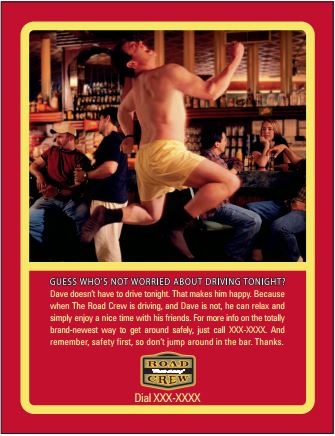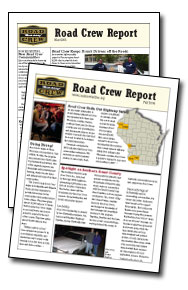
Road Crew was one of five projects funded by the National Highway Traffic Safety Administration, seeking a five per cent reduction in alcohol-related crashes in the pilot communities.This was their website ofr Wisconsin citizens. Road Crew, was an innovative approach to preventing people who drank too much from driving. By offering their services to drive heavy drinkers from bar to bar, the Road Crew kept their communities safe from drivers who have had too much to drink. Many folks thought it was a great service to everyone while it lasted. Others considered it rather controversial since it make the acceptance of heavy drinking acceptable. Nevertheless, the primary target audience for Road Crew was 21- to 34-year-old single, male, blue-collar workers in rural areas. By As of 2008, Road Crew had:
- Given over 97,000 rides
- Prevented an estimated 140 alcohol-related crashes
- Saved an estimated six lives from alcohol-related crashes
Comparing the estimated cost of avoiding a crash by implementing Road Crew at US$6,400, and the cost to a community to recover from a crash at US$231,000, Road Crew has shown savings estimated at over US $31 million.
I grew up in rural Wisconsin and understand the culture. At the time Road Crew was initiated it was heralded by many as a successful social marketing project that really used the motivations of the target audience to create appropriate interventions. That was 2008, jump ahead to the present. I am now living in Brooklyn NY and am doing a dissertation on America's drinking and driving laws that are collectively known as "Operating a Vehicle Under the Influence" (OVI) and the effectiveness of their Drivers’ intervention programs. There is a huge amount of data here, so I'm working with a DevOps consultant who is helping to create the software needed to quickly address a topic as comprehensive as this one. We're accessing hundreds of databases to gather not only legal analysis, but also studies conducted by research groups, schools, agencies, etc. DevOps permits the simultaneous development and testing of the software to improve development times and cut down on bugs. It's really fascinating to be involved in this project and I'm learning more about how to improve the capabilities of researchers along with the information specifically related to driver intervention programs. And I'm really glad this topic is of interest to those who may make a difference to our safety on the road!
Now Recruiting New Communities
 With the federal fiscal year starting on October 1, 2007, Road Crew is now poised to fund new communities. The Wisconsin Department of Transportation has restructured the program funding to provide up to three research and developments grants of $5,000 each to prospective communities for a six-month planning and preparation period, followed by up to three grants of $30,000 each for a one-year program implementation. Interested communities should contact us for more information.
With the federal fiscal year starting on October 1, 2007, Road Crew is now poised to fund new communities. The Wisconsin Department of Transportation has restructured the program funding to provide up to three research and developments grants of $5,000 each to prospective communities for a six-month planning and preparation period, followed by up to three grants of $30,000 each for a one-year program implementation. Interested communities should contact us for more information.Research Supports Road Crew Impact
*Subject to change - additional ride counts pending.
 Welcome to Road Crew, the innovative approach to reducing drunk driving. Pioneered in several rural Wisconsin counties, Road Crew has proven itself to be a popular and easy way for drinkers to get around without their vehicles, while keeping communities safe from drivers who have had too much to drink.
Welcome to Road Crew, the innovative approach to reducing drunk driving. Pioneered in several rural Wisconsin counties, Road Crew has proven itself to be a popular and easy way for drinkers to get around without their vehicles, while keeping communities safe from drivers who have had too much to drink.
Road Crew Delivers
 Before drinkers go out for the evening, they arrange a ride with Road Crew. Vehicles pick up customers at their home, drive them around all evening from bar to bar, then deliver them home safely at the end of the night. Road Crew adds to the fun of a night out by providing a way for people to socialize together.
Before drinkers go out for the evening, they arrange a ride with Road Crew. Vehicles pick up customers at their home, drive them around all evening from bar to bar, then deliver them home safely at the end of the night. Road Crew adds to the fun of a night out by providing a way for people to socialize together.
Community Involvement
In the communities it serves, Road Crew has the endorsement and participation of law enforcement, tavern owners and servers, government officials, businesses, and the public at large. It brings together groups and individuals around a common goal of reducing crashes, injuries, and fatalities.
A Brief History
 Founded in 2001, Road Crew has grown to provide service in six Wisconsin counties, serving 36 communities. As of September 30, 2007, Road Crew has given over 85,000 rides, and has prevented an estimated 140 alcohol-related crashes and six alcohol related fatalities. The costs incurred from an alcohol-related crash are approximately $231,000, but the cost to avoid a crash through the use of Road Crew is approximately $6200. This means that it is about 37 times more expensive to incur a crash than it is to avoid a crash. Total net savings through the use of Road Crew has been about $31 million. (Source: The Impact of Road Crew on Crashes, Fatalities, and Costs, Michael L. Rothschild, Principal Investigator, Road Crew, October 18, 2007, available upon request from roadcrew@mascomm.net.)
Founded in 2001, Road Crew has grown to provide service in six Wisconsin counties, serving 36 communities. As of September 30, 2007, Road Crew has given over 85,000 rides, and has prevented an estimated 140 alcohol-related crashes and six alcohol related fatalities. The costs incurred from an alcohol-related crash are approximately $231,000, but the cost to avoid a crash through the use of Road Crew is approximately $6200. This means that it is about 37 times more expensive to incur a crash than it is to avoid a crash. Total net savings through the use of Road Crew has been about $31 million. (Source: The Impact of Road Crew on Crashes, Fatalities, and Costs, Michael L. Rothschild, Principal Investigator, Road Crew, October 18, 2007, available upon request from roadcrew@mascomm.net.)
 We are proud to share our philosophies and methods with you. Best wishes for your success in making roadways safer for your community's residents and visitors. For more information, you can read our full report published by the Department of Transportation, read the research paper, Reducing Alcohol-Impaired Driving Crashes Through the Use of Social Marketing by Rothschild, Mastin, and Miller (2006), published in Accident Analysis and Prevention (PDF), or contact the Road Crew program office.
We are proud to share our philosophies and methods with you. Best wishes for your success in making roadways safer for your community's residents and visitors. For more information, you can read our full report published by the Department of Transportation, read the research paper, Reducing Alcohol-Impaired Driving Crashes Through the Use of Social Marketing by Rothschild, Mastin, and Miller (2006), published in Accident Analysis and Prevention (PDF), or contact the Road Crew program office.
|
Michael L. Rothschild |
Beth Mastin |
Road Crew is a program of The Wisconsin Department of Transportation, Bureau of Transportation Safety in collaboration with the University of Wisconsin School of Business and MasComm Associates, with additional support from the Tavern League of Wisconsin.
Now Recruiting New Communities
Research Supports Road Crew Impact
More Background On RoadCrewOnline.org
RoadCrewOnline.org was the digital platform for the Road Crew initiative, a pioneering program aimed at reducing alcohol-impaired driving in rural Wisconsin. Launched in the early 2000s, the initiative was a collaborative effort involving the Wisconsin Department of Transportation, the University of Wisconsin School of Business, and MasComm Associates. The program's primary objective was to decrease alcohol-related crashes by offering an alternative transportation service for individuals who had been drinking, thereby preventing them from driving under the influence.
Historical Context and Development
In the late 1990s and early 2000s, Wisconsin faced a significant challenge with alcohol-related traffic incidents, particularly in its rural areas. Traditional deterrents, such as legal penalties and public awareness campaigns, had limited success in curbing drunk driving among certain demographics, notably 21- to 34-year-old single males in blue-collar jobs. Recognizing the need for a more targeted approach, the Wisconsin Department of Transportation sought innovative solutions. This led to the conception of the Road Crew program, which was designed to align with the social habits and preferences of the target audience.
Program Structure and Services
The Road Crew program offered a unique transportation service tailored to the lifestyle of its users. Participants could arrange for a ride that would pick them up from their homes, transport them to various bars or social venues, and ensure they returned home safely at the end of the night. This door-to-door service was designed to eliminate the need for individuals to drive their own vehicles when planning to consume alcohol, thereby reducing the temptation to drive under the influence.
To enhance the appeal of the service, the program utilized older luxury vehicles, such as limousines, which added a sense of novelty and enjoyment to the experience. This approach not only provided a practical solution but also enhanced the social experience of a night out, making it more attractive to the target demographic.
Community Engagement and Support
A cornerstone of the Road Crew's success was its deep integration into the communities it served. The program garnered support from various local stakeholders, including law enforcement agencies, tavern owners, government officials, and businesses. This broad coalition was essential in promoting the service and ensuring its acceptance among potential users. By involving community members in the planning and implementation phases, the program was able to tailor its services to meet local needs effectively.
Impact and Outcomes
The Road Crew program demonstrated significant success in achieving its objectives. By 2008, the initiative had provided over 97,000 rides, prevented an estimated 140 alcohol-related crashes, and saved approximately six lives. Financial analyses indicated that the cost of implementing the program was substantially lower than the expenses associated with alcohol-related accidents, resulting in estimated savings of over $31 million for the communities involved.
Cultural and Social Significance
Beyond its immediate impact on road safety, the Road Crew program played a pivotal role in shifting cultural attitudes toward drinking and driving in rural Wisconsin. By offering a convenient and socially acceptable alternative to driving under the influence, the program helped normalize the use of designated driver services. This cultural shift contributed to a broader acceptance of responsible drinking behaviors and highlighted the importance of community-based solutions in addressing public health issues.
Legacy and Influence
The success of the Road Crew program has served as a model for similar initiatives across the United States and internationally. Its innovative use of social marketing principles to address a public health concern has been widely studied and replicated. The program's emphasis on understanding the target audience's motivations and behaviors, and designing services that align with those insights, has influenced the development of other public safety and health promotion programs.
RoadCrewOnline.org was the digital embodiment of a groundbreaking initiative that combined community engagement, innovative service design, and strategic marketing to tackle the persistent issue of drunk driving. The program's legacy continues to inform and inspire efforts to promote road safety and responsible drinking behaviors worldwide.